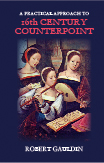
312 pages, $57.95 list
1-4786-0471-9
978-1-4786-0471-6
© 2013
plastic comb
eBook availability
A Practical Approach to 16th Century Counterpoint, Revised Edition
Practical work in writing counterpoint! Gauldin emphasizes the acquisition of writing skills in the contrapuntal discipline and the simulation of sixteenth-century sacred polyphonic idioms in this volume. The author follows a didactic method of a “non-species or direct” approach. While no previous contrapuntal training is necessary to absorb this material, some acquaintance with Baroque polyphonic terminology proves helpful.
Key features include: musical examples illustrating specific devices are taken from musical literature or composed by the author; demonstrates the possibility of employing a single given pitch series within the contexts of different compositional techniques; includes a collection of complete or excerpted movements drawn from musical literature at the conclusion of each major textual division; emphasizes Palestrina and the Counter-Reformation sacred style; discusses various compositional procedures of the late Renaissance, including paraphrase, cantus firmus, familiar style, parody, polychoral technique, and chromaticism.
Key features include: musical examples illustrating specific devices are taken from musical literature or composed by the author; demonstrates the possibility of employing a single given pitch series within the contexts of different compositional techniques; includes a collection of complete or excerpted movements drawn from musical literature at the conclusion of each major textual division; emphasizes Palestrina and the Counter-Reformation sacred style; discusses various compositional procedures of the late Renaissance, including paraphrase, cantus firmus, familiar style, parody, polychoral technique, and chromaticism.
Reactions
“This new edition makes a classic text even better. Gauldin’s text is exceptional in the way that it immediately gets students writing. I am amazed at how quickly and naturally students with no prior compositional experience get past the fear of composing. Gauldin makes sixteenth-century counterpoint approachable and, most importantly, musical.” — Richard Pellegrin, University of Missouri
1. Preliminary Remarks
2. Melodic Writing with White Notes
3. Two-Voice Texture with White Notes
4. Melodic Writing with Black Notes
5. Two-Voice Texture with Black Notes
6. Other Aspects of Two-Voice Texture
7. Examples of Two-Voice Compositions for Analysis
8. Three-Voice Texture with White Notes
9. Cadences in Three-Voice Texture; Other White-Note Dissonance
10. Black Notes in Three-Voice Texture; Imitation and Reentries
11. Paraphrase Technique; Further Studies in Canon
12. Examples of Three-Voice Compositions for Analysis
13. General Considerations of Four-Voice Texture; Familiar Style
14. Imitation and Reentry in Four-Voice Texture; Cantus Firmus Technique
15. Examples of Four-Voice Compositions for Analysis
16. Aspects of Five- and Six-Voice Texture; Triple Meter
17. The Motet; Parody Technique
18. Examples of Five- and Six-Voice Compositions for Analysis
19. Eight-Voice Texture; Polychoral Style
20. Examples of Eight-Voice Compositions for Analysis
21. Additional Harmonic Devices in the Late Sixteenth Century
22. Extended Musica Ficta and Chromaticism
Appendix 1
Appendix 2
Appendix 3
Bibliography
Texts
Historical Treatises (Available in English)
Anthologies
Related Books, Articles, and Analyses
2. Melodic Writing with White Notes
3. Two-Voice Texture with White Notes
4. Melodic Writing with Black Notes
5. Two-Voice Texture with Black Notes
6. Other Aspects of Two-Voice Texture
7. Examples of Two-Voice Compositions for Analysis
8. Three-Voice Texture with White Notes
9. Cadences in Three-Voice Texture; Other White-Note Dissonance
10. Black Notes in Three-Voice Texture; Imitation and Reentries
11. Paraphrase Technique; Further Studies in Canon
12. Examples of Three-Voice Compositions for Analysis
13. General Considerations of Four-Voice Texture; Familiar Style
14. Imitation and Reentry in Four-Voice Texture; Cantus Firmus Technique
15. Examples of Four-Voice Compositions for Analysis
16. Aspects of Five- and Six-Voice Texture; Triple Meter
17. The Motet; Parody Technique
18. Examples of Five- and Six-Voice Compositions for Analysis
19. Eight-Voice Texture; Polychoral Style
20. Examples of Eight-Voice Compositions for Analysis
21. Additional Harmonic Devices in the Late Sixteenth Century
22. Extended Musica Ficta and Chromaticism
Appendix 1
Appendix 2
Appendix 3
Bibliography
Texts
Historical Treatises (Available in English)
Anthologies
Related Books, Articles, and Analyses